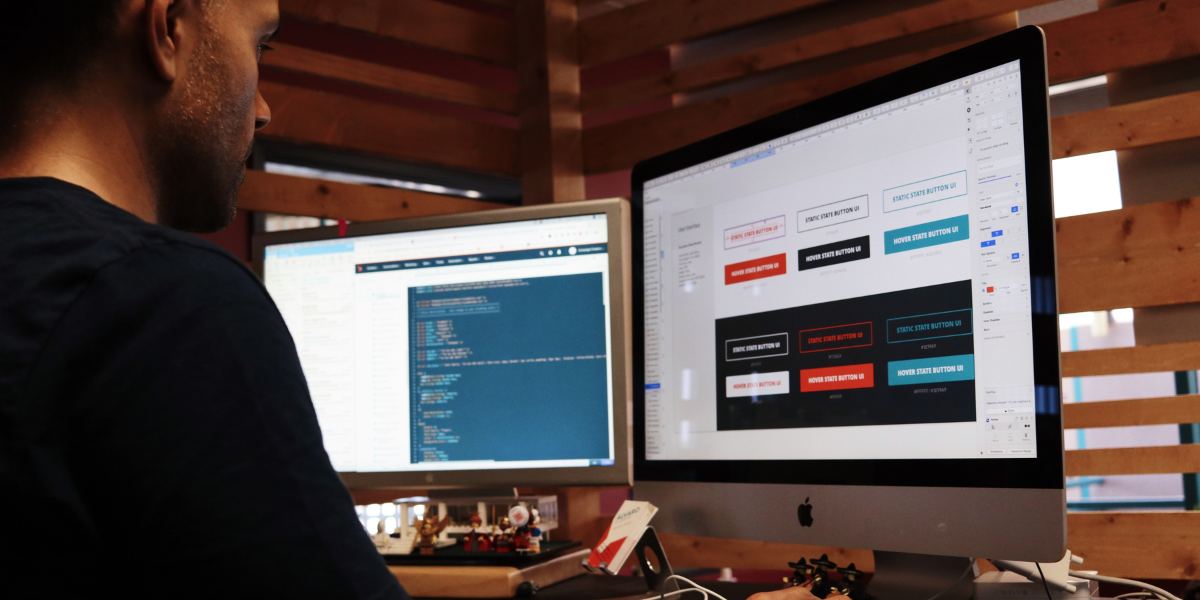SEO & Web Design: Everything You Need to Know
- By Tracy
- 16-06-2023
- SEO

Increasing a website's visibility in search results is the goal of Search Engine Optimization (SEO). Any company with online aspirations has to pay attention to website design. The layout of your site is yet another factor that has to be optimized so that it ranks well in Search Engine Results Pages (SERPs). Existing clients and prospective new ones won't be able to readily access your website if it doesn't appear in the search rankings on the first two pages. Your new site's design is crucial to its success, and you should only trust it to a web design firm that also provides thorough SEO services.
However, companies seldom consider SEO until after they have contracted a website design firm to build or revamp their site. The final products seem wonderful, but they lack fundamental SEO principles.
SEO-Friendly Web Design Services
SEO and website development go hand in hand. Avoiding building a website that isn't search engine friendly requires a web design business to have a firm grasp of the fundamentals of SEO. SEO has to be a component of every website design project. This helps the site get more visitors from search engines and raises the results for related queries.
Good SEO relies heavily on UX, which is heavily influenced by how a website looks and functions. By considering how search engines index and interpret websites, an SEO web design firm may develop an initial framework for a site. Ultimately, this facilitates indexing the website's pages by those search engines.
Listed below are basic web design and SEO concepts that should be included in the website design of any organization. Verify that the web design company you choose recognizes the significance of these guidelines. This makes the site more accessible to search engines without compromising its distinctive design.
Fundamentals
A well-optimized website design process relies on a few foundational factors.
Domains
Your domain must be relevant to your business. Example.com may serve as your company's main domain. But there might be more. Having all your different domain names and sub-domains properly redirect to your main domain is crucial.
Don't be fooled by the fact that my domain name contains my targeted keywords. It's simply not a good look. Local companies may benefit somewhat from this, but it's important to be accurate in your mapping. Be rational.
Hosting
It's also crucial that you host. Users are more likely to get frustrated with a sluggish website. It would help if you used common sense while hosting. Hurry up. Position yourself where your target audience is. If you must, target a certain platform. One such service that offers a platform designed specifically for WordPress websites is WP Engine.
CMS
Your company's performance may depend critically on the CMS (content management system) you use. WordPress is an excellent platform for many uses, but it is not without competition. At its most fundamental level, it is connected in a manner that Google can comprehend it. This doesn't mean it's the perfect fit for your company, but it is a fantastic place to begin. Choose a content management system (CMS) based on its suitability for your needs, not on the preference of the web design firm you hire.
Crawling & accessibility
The first thing you need to do is make your site search engine friendly so that search engines can find it and understand what you do and where you do it.
Indexation
They need reading comprehension skills to get anything out of your site. This implies that the bulk of your site's information should be textual. No visuals. This means no videos or flash. Despite how fast the world changes, the text should still make up the bulk of your material. Be careful to speak about what you do in plain language so the search engine can read and comprehend your offering; fantastic tools like web fonts ensure you can still look the part and your photographs have a place.
Content in the form of images, videos, PDFs, and written text is also valuable since it may attract users from search engines. These, too, must be searchable and indexed.
Link structure
Your site must have followable internal links for search engines to index any pages beyond the homepage. XML sitemaps, search engine directives, and other tools all aid in the search engine's ability to crawl your site and find new pages. Screaming Frog and other similar tools may assist you in guaranteeing that search engines can scan your site.
Site Structure and Information Architecture
A well-defined website architecture and navigation are one of the first concepts an SEO web design firm should handle throughout the web design process. Website architecture refers to the overall layout of your site. A well-organized design is essential for user experience since it will draw people in and keep them from leaving your site in droves. A high bounce rate might hamper SEO.
Aurora Web Design specializes in creating fully customized and user-friendly websites tailored to unique brand and business needs. The firm designing your website must prioritize user friendliness while developing the site's information architecture and navigation. To increase your website's conversion rate, it's important that search engines can browse your web pages and that internal links are placed strategically.
Mobile-Friendly and Responsive Design
In 2015, mobile friendliness became a major ranking criterion for Google. In 2017, mobile traffic accounted for 52.64 percent of the world's total web traffic. Also, in 2018, Google promised that all websites would be indexed using mobile-first indexing by September. This necessitates that all websites be mobile-friendly.
Responsive design, which considers mobile users' preferences, is the key to making a site mobile-friendly. A responsively built website adapts to the visitor's device to provide an optimal viewing and interaction experience.
This case study of responsive web design illustrates how an online store may be optimized for viewing on any mobile device without sacrificing the quality of its photos or text.
Usability
Bad user experience design is a direct result of poor usability. When a website is easy to use, visitors are likelier to stick around and make a purchase or other conversion.
- Important aspects of a site's usability:
- Page design and layout
- Website navigation
- Graphic hierarchy
- Site search
- Contact forms
- Clear and consistent calls-to-action (CTAs)
Easy-to-Read Site Design
The design of a website may have a profound effect on its content, yet many people fail to see this. Websites with bad designs make it hard for visitors to read the information.
Here are several drawbacks to web design that your company should be aware of:
- Content with chunks of content in odd places
- Too many hyperlinks
- White or black background for colored text
- Too big or small font size
If users are confused by any of these issues, they are more likely to abandon your site. In addition to raising your site's bounce rate, this will damage your company's credibility and drive customers to your rivals.
Web Design Optimized for Conversions
Your website is failing if it is not bringing in visitors who are also prospective buyers. Only a website optimized for conversion rates will be successful at turning visitors into buyers. An increase in sales may be attributed to CRO.
The next step you want your visitor to take should be intuitively clear as they go through your website. A conversion-optimized website employs a robust SEO strategy, a sleek and readily accessible design, and several suggestive buttons, often called calls to action. Your desired outcome may be a contact form submission, a product purchase, a service reservation, or an appointment booking. This website case study is just one example of how careful attention to website design and structure can increase conversion rates by as much as 30 percent annually.
Site Speed Design
Website design firms should keep in mind that the speed with which their clients' sites load is important to their success. Bad user experience and increased bounce rates might be the consequence of design aspects that cause your company website to take too long to load. One of the primary causes of high bounce rates is slow page loading times. Most of your visitors won't even wait for your site to load, which means that even if you have beautiful huge graphics, animation, and other complex design features, they won't be seen.
By keeping visitors on your site for longer, a faster loading time guarantees a better UX and increases the likelihood that they will convert after seeing your calls to action. With the help of web design services, you can make your site load faster by eliminating the features that slow it down.
Optimize Images
Every website relies heavily on image files; optimizing them is essential for aesthetics and search engine rankings.
When deciding which photographs to use on your website, there are a few things to keep in mind:
- Give the image a name that accurately expresses its subject.
- To make a picture more visible to viewers who are blind or visually challenged, add descriptive alt text.
- Use the proper picture size for quick downloads.
The content marketing funnel
Your website has a monumental task: it must aid your company in being discovered by potential consumers through search engines, and then it must attract, engage, and ultimately convert those customers.
All of these points throughout the consumer journey need content from your site. When used with SEO, content may bring you to the attention of a potential consumer just as they are researching competitors' offerings of comparable services.
The material you require may be thought about systematically using a marketing funnel.
Top of the funnel: Awareness
Blog posts and informative articles are common forms of awareness material. By doing this, we're making it easier for your potential consumer to see that you fully grasp the challenges they encounter and can provide effective solutions.
- Blog posts
- Informative articles
- Webinars
- Thorough guidelines
- FAQs
Middle of the funnel: Consideration
When your prospect is considering you, the material enables them to compare you and other options. This often contains useful information that aids in the customer's decision-making.
- Case studies
- Product or service details
- Product demonstration videos
- User guides
Bottom of the funnel: Conversion
Conversion-driven content towards the bottom of the funnel should subtly nudge readers toward a lead or purchase.
- Reviews
- Testimonials
- Unrestricted trial
- Open Consultation
Keep in mind that consumers will do searches throughout the whole gamut of these content kinds. To increase your chances of being found via search engines, considered, and converted, ensure all of these are covered.
Conclusion
In conclusion, every company that wants to succeed online has to have a well-designed website. Web design and SEO work hand in hand, and to guarantee that a website is search engine friendly, a web design business must be familiar with the fundamentals of SEO. The website will be more user-friendly and rank well on SERPs for pertinent search terms if it incorporates fundamental elements such as domains, hosting, CMS, crawling, accessibility, indexation, link structure, site structure, and information architecture. It will also be mobile-friendly and responsive. To maximize the potential for search engine traffic and higher conversion rates on the website, companies should collaborate with an SEO web design firm that can develop a thorough SEO strategy throughout the web design process.
Frequently Asked Questions (FAQs)
Why is web design important for SEO?
SEO relies heavily on user experience (UX), which is heavily influenced by how well-designed a website is. To increase traffic and conversions, you need a search-engine-optimized website that users like interacting with.
How can I make my website more search-engine friendly?
Important web design and SEO concepts should be included throughout the website design process to make your site more search engine friendly. The correct domain, hosting, and content management system (CMS), as well as optimized crawling and accessibility, a well-organized link structure, and a mobile-friendly, responsive design, are all part of this.
Why should I choose an SEO web design company?
By working with an SEO web design firm, you can be certain that your site will be built using best practices for aesthetics and SEO. As a result, not only will your website look amazing, but it will also be search engine optimized, which will boost its ranks and bring in more visitors.
What is responsive design, and why is it important for SEO?
The term "responsive design" refers to a method of web development that guarantees a website's optimal viewing and navigational experience across all platforms and devices. It's crucial for SEO since Google now gives mobile-friendly sites a boost in the SERPs, demoting those not optimized for mobile devices.
Can I optimize my existing website for search engines?
Optimizing a website for search engines includes analyzing its current state and changing its structure, content, and technological features. SEO of an already-existing website is possible. However, rather than attempting to retrofit SEO concepts onto an already established website, optimizing your website throughout the design phase is generally simpler and more successful.





